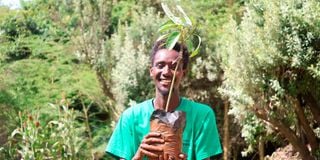Pastoralists embrace farming to fight climate change, boost food security

Leshan Koisikir, an environmentalist, at his Olepolos farm in Narok.
What you need to know:
- Kenya is a signatory to the global methane pledge whose goal is to reduce methane emissions by 30 per cent by 2030.
Leshan Koisikir,29, is a man on a mission — he says he wants to see his pastoral community live a healthy life amid the climate crisis that has made livestock keeping an unreliable source of livelihood.
Having graduated with a Diploma in Community Health and Development at Moi University in 2016, Leshan embraced environmental conservation after seeing that the only career opportunities he was getting were volunteer jobs, making it difficult for him to provide for himself and his family. He has partitioned his 20 acres of land in Olepolos, Narok for different agricultural activities. He farms food crops like beans, maize, sorghum, vegetables and sweet potatoes. He also keeps bees, poultry and rabbits besides growing fruit trees like avocados, sweet berries and indigenous trees within his homestead, thanks to his inspiration for agribusiness and environmental conservation.
His land is located near Ewaso Nyiro River. This makes it easier for him to depend on water from the river for irrigation as the region receives little rainfall. However, he faces challenges such as lack of a market for honey and professional harvesting equipment.
The third born in a family of four inherited the plot from his father, who is also an environmentalist; who admits that climate change has posed a threat and changed livelihoods of pastoral communities in Narok, an arid and semi-arid region. “Things have changed. Nowadays, residents keep the number of livestock according to the size of their land as we are gradually embracing farming,” says Mr James Koisikir.
According to Kennedy Oyugi, an agricultural economist at Africa Harvest, short-seasoned crops ensure food security in pastoral homes.
“The pastoralists are diversifying and this helps them to harvest crops even with the limited rainfall,” Mr Oyugi tells Climate Action.
Roy Bouwer from the African Climate Action Partnership says that when pastoralists embrace other agricultural practices for livelihood even as they continue rearing livestock, they increase their income through gradual adaptation to climate change. “This might require a lot of resources in the beginning, but the outcomes will benefit them enormously once they become open to adapting to new agricultural practices,” Mr Bouwer says.
Globally, agriculture accounts for about 40 per cent of human-caused emissions of methane, a potent greenhouse gas. Cutting methane is one of the fastest ways to slow global warming, and the majority of agricultural methane emissions come from livestock farming. Methane gas from livestock comes from the burp that ruminants (animals that chew part of what they had already ingested in their stomach, commonly known as cud) release.
According to scientists, keeping productive herds of livestock and selling them as soon as their productivity starts to decline, feeding them on protein-rich fodder, and managing their manure limits the amount of methane gas they release. Dr Joel Onyango, a research scientist from the African Centre of Technology Studies, says a majority of livestock farmers in the country are adapting to climate change in their little ways.
“When we talk about reducing emissions, the target is often not to reduce the absolute emission in terms of productivity reduction. You reduce emission intensity by reducing the amount you emit per unit of product you get,” Dr Onyango explains.
According to Aimable Uwizeye, who in charge of the Animal Production and Health Division at the Food and Agriculture Organization, the challenge is how to improve the management of animals in pastoral regions where methane emissions remain higher. “The productivity of pastoral animals in terms of milk is one to three litres a day, but if you look at the composition of pastoral systems, you will see many bulls in there and they are kept for long yet that does not make sense because when drought strikes, it wipes out all the weak animals,” says Mr Uwizeye.
Kenya is a signatory to the global methane pledge whose goal is to reduce methane emissions by 30 per cent by 2030. While Mr Koisikir in Narok is unaware of this pledge, each new day is a chance for him to motivate his pastoral community to embrace other agricultural practices alongside keeping livestock.
“I want to change my land into a demonstration farm so that people can come to borrow lessons and go back to implement on their farms. Most of my pastoral communities are still into livestock keeping but nowadays we sell most of our animals to earn money,” Mr Koisikir tells Climate Action.





